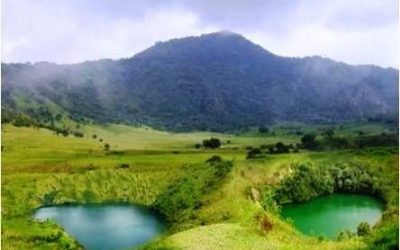CROSS RIVER GORILLA IS SLAIN

The loss of the majestic Cross River gorilla shocked Cameroon’s wildlife officials, conservationists and other observers.
Only 300 Cross River gorillas remain in the wild between the Cameroon-Nigeria border region, yet the order to kill a harmless member of Africa’s rarest and most endangered ape came from the Chief of Gendarmerie Brigade based in Pinyin.
The then wildlife expert for the Environment and Rural Development Foundation (ERuDeF), Neba Bedes, had said the Silverback was killed on the pretext of self-defence.
“No investigation was carried out to ascertain whether the slain gorilla was a threat to the community,” said Neba.
The unfortunate Silverback and its cousin, the equally endangered Nigeria-Cameroon chimpanzee, surviving in the Cameroon-Nigeria border region, are among the wildlife species faced with the dangers emanating from reckless killings, hunting and habitat loss.
The Cross River gorilla and the Nigeria-Cameroon chimpanzee, including the African forest elephant found in this area, are extremely vulnerable to human destruction. Villagers tend to fragment the habitats of the apes, thereby hindering genetic variation between the sub-populations of Cross River gorilla in Tofala Hill Wildlife Sanctuary and Takamanda National Park, thus increasing the possibility of inbreeding. Meanwhile, entire forests have been wiped out by loggers cutting down trees for timber or farmers clearing and setting fire to the forest to make way for cocoa and palm plantations. Illegal hunting of the threatened species coupled with ignorance of forestry and wildlife law, also take thier toll.
The Cross River gorilla and the Nigeria-Cameroon chimpanzee desperately need help to ensure their safety. To this end, in 2004, ERuDeF, after research, began advocating for the creation of a sanctuary to promote the conservation of the threatened apes. And in 2014, the government of Cameroon created the Tofala Hill Wildlife Sanctuary (THWLS).
The THWLS covers a surface area of 8,087 hectares, generally ensuring the safety of plants. But for the apes, poverty and misunderstanding remain the number one threat to their survival. Poverty and weak rural economy are impediments to conservation efforts. The villagers adjacent to protected areas still live from hand to mouth, depending on subsistence farming and petty trading. The pressures of population are also increasing and many villages can still be reached only on foot or by motorcycle. Meanwhile, insufficient environmental information and environmental programmes, inadequate school infrastructure and equipment such as benches, libraries, toilets to ensure suitable learning environment; all these lead to many children dropping out of school, thus causing them to return to the forest for their livelihood. This exerts more pressure on the habitats of the apes. ERuDeF, therefore, tries to balance preservation of the endangered wildlife species with education and economic development. It takes into account not merely the flow of conservation information but also access to stimuli to income-generating activities. The organization stresses the improvement of physical, social and economic health of villagers adjacent to protected areas through services such as donations of piglets and beehives, scholarships and educational materials.
ERuDeF’s over a decade of conservation have focused on these. As a result, hundreds of piglets and beehives have been provided free of cost to villagers especially in Lebialem. These approaches are still being refined and the process requires funding for any tangible success to be achieved.
In the month of June 2015, over 75 households made up of hunters, trappers, youths, women and farmers, who live adjacent to the proposed Mak-Betchou Wildlife Sanctuary in Lebialem Division in the Southwest Region benefitted donations of piglets, Kenyan top bar beehives, and animal feed from ERuDeF’s Livelihoods and Economic Development Programme. The villagers had previously been trained on bee farming, livestock production, petty business initiation and the sustainable extraction of Non-Timber Forest Products (NTFPs) as well as sustainable agriculture so as to divert them from foraying into the proposed protected area.
By Azore Opio



